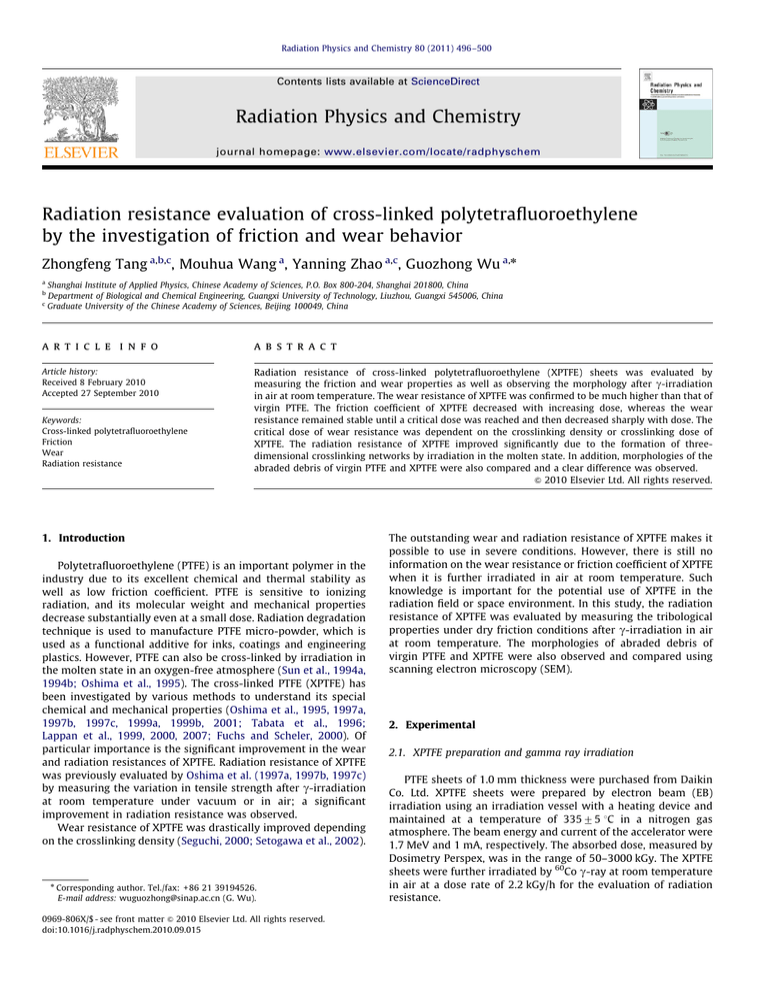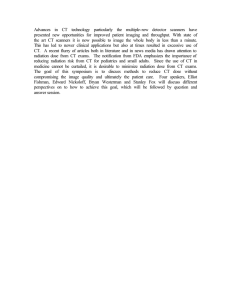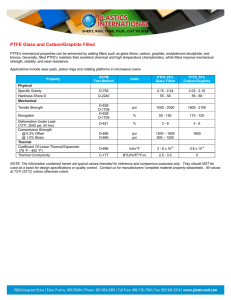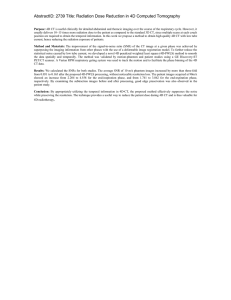
Radiation Physics and Chemistry 80 (2011) 496–500
Contents lists available at ScienceDirect
Radiation Physics and Chemistry
journal homepage: www.elsevier.com/locate/radphyschem
Radiation resistance evaluation of cross-linked polytetrafluoroethylene
by the investigation of friction and wear behavior
Zhongfeng Tang a,b,c, Mouhua Wang a, Yanning Zhao a,c, Guozhong Wu a,n
a
Shanghai Institute of Applied Physics, Chinese Academy of Sciences, P.O. Box 800-204, Shanghai 201800, China
Department of Biological and Chemical Engineering, Guangxi University of Technology, Liuzhou, Guangxi 545006, China
c
Graduate University of the Chinese Academy of Sciences, Beijing 100049, China
b
a r t i c l e in f o
a b s t r a c t
Article history:
Received 8 February 2010
Accepted 27 September 2010
Radiation resistance of cross-linked polytetrafluoroethylene (XPTFE) sheets was evaluated by
measuring the friction and wear properties as well as observing the morphology after g-irradiation
in air at room temperature. The wear resistance of XPTFE was confirmed to be much higher than that of
virgin PTFE. The friction coefficient of XPTFE decreased with increasing dose, whereas the wear
resistance remained stable until a critical dose was reached and then decreased sharply with dose. The
critical dose of wear resistance was dependent on the crosslinking density or crosslinking dose of
XPTFE. The radiation resistance of XPTFE improved significantly due to the formation of threedimensional crosslinking networks by irradiation in the molten state. In addition, morphologies of the
abraded debris of virgin PTFE and XPTFE were also compared and a clear difference was observed.
& 2010 Elsevier Ltd. All rights reserved.
Keywords:
Cross-linked polytetrafluoroethylene
Friction
Wear
Radiation resistance
1. Introduction
Polytetrafluoroethylene (PTFE) is an important polymer in the
industry due to its excellent chemical and thermal stability as
well as low friction coefficient. PTFE is sensitive to ionizing
radiation, and its molecular weight and mechanical properties
decrease substantially even at a small dose. Radiation degradation
technique is used to manufacture PTFE micro-powder, which is
used as a functional additive for inks, coatings and engineering
plastics. However, PTFE can also be cross-linked by irradiation in
the molten state in an oxygen-free atmosphere (Sun et al., 1994a,
1994b; Oshima et al., 1995). The cross-linked PTFE (XPTFE) has
been investigated by various methods to understand its special
chemical and mechanical properties (Oshima et al., 1995, 1997a,
1997b, 1997c, 1999a, 1999b, 2001; Tabata et al., 1996;
Lappan et al., 1999, 2000, 2007; Fuchs and Scheler, 2000). Of
particular importance is the significant improvement in the wear
and radiation resistances of XPTFE. Radiation resistance of XPTFE
was previously evaluated by Oshima et al. (1997a, 1997b, 1997c)
by measuring the variation in tensile strength after g-irradiation
at room temperature under vacuum or in air; a significant
improvement in radiation resistance was observed.
Wear resistance of XPTFE was drastically improved depending
on the crosslinking density (Seguchi, 2000; Setogawa et al., 2002).
n
Corresponding author. Tel./fax: + 86 21 39194526.
E-mail address: wuguozhong@sinap.ac.cn (G. Wu).
0969-806X/$ - see front matter & 2010 Elsevier Ltd. All rights reserved.
doi:10.1016/j.radphyschem.2010.09.015
The outstanding wear and radiation resistance of XPTFE makes it
possible to use in severe conditions. However, there is still no
information on the wear resistance or friction coefficient of XPTFE
when it is further irradiated in air at room temperature. Such
knowledge is important for the potential use of XPTFE in the
radiation field or space environment. In this study, the radiation
resistance of XPTFE was evaluated by measuring the tribological
properties under dry friction conditions after g-irradiation in air
at room temperature. The morphologies of abraded debris of
virgin PTFE and XPTFE were also observed and compared using
scanning electron microscopy (SEM).
2. Experimental
2.1. XPTFE preparation and gamma ray irradiation
PTFE sheets of 1.0 mm thickness were purchased from Daikin
Co. Ltd. XPTFE sheets were prepared by electron beam (EB)
irradiation using an irradiation vessel with a heating device and
maintained at a temperature of 33575 1C in a nitrogen gas
atmosphere. The beam energy and current of the accelerator were
1.7 MeV and 1 mA, respectively. The absorbed dose, measured by
Dosimetry Perspex, was in the range of 50–3000 kGy. The XPTFE
sheets were further irradiated by 60Co g-ray at room temperature
in air at a dose rate of 2.2 kGy/h for the evaluation of radiation
resistance.
Z. Tang et al. / Radiation Physics and Chemistry 80 (2011) 496–500
497
Fig. 1. Configuration of the friction pairs (MMW-1A model tester). (a) ring-on-ring contact, (b) counterpart ring and (c) sample ring.
2.2. DSC measurement and tribological testing
Thermal analysis was carried out using a differential scanning
calorimeter (DSC) (Mettler TA822e) under nitrogen atmosphere.
Both heating and cooling rates were 10 1C/min.
The tribological tests were conducted on the ring-on-ring
friction and wear tester (MMW-1 A model, Jinan Yihua Tribology
Testing Co. Ltd., China) illustrated in Fig. 1. The counter-face
material was ^ 45 steel, and the steel ring was 50 mm in external
diameter, 42 mm in inner diameter and 8 mm in thickness. Before
each test, the surface of the sample and the counterpart ring were
polished with 800 grit paper to a surface roughness of 0.2–0.4 mm
and cleaned with alcohol. The test was performed under dry
friction and ambient conditions (temperature: 25 1C, humidity:
50%) at sliding velocities of 0.24 m/s and normal loads of 200 N.
The test time was 120 min. During the test, the friction force was
measured with a sensor and recorded with test time automatically.
The friction coefficient was calculated from the friction force
(the measurement errors of the friction coefficient were 75%). The
wear loss of each sample was calculated from the weight loss. The
wear rate (k) is defined by the following equation:
Table 1
Melting point and crystallization enthalpy of XPTFE samples measured by DSC.
Sample code
EB dose for
crosslinking
(kGy)
g-ray
dose
(kGy)
Melting point
Tm (1C)
Enthalpy of
crystallization
DHc (J/g)
PTFE
XPTFE50
XPTFE500
XPTFE3000
XPTFE500-50
XPTFE500-200
0
50
500
3000
500
500
0
0
0
0
50
200
327
326
316
280
321
324
26
41
35
23
50
55
k ¼ Wv ðmm3 Þ=FN SðNmÞ
where Wv is the wear loss volume of material, FN the normal load
and S the sliding distance.
The worn surface and debris of specimens were observed by
SEM (JSM-5600LV, JEOL. Co.).
3. Results and discussion
3.1. Radiation effect on friction coefficient and wear resistance of
XPTFE
XPTFE sheets were prepared by EB irradiation in the molten
state in a nitrogen atmosphere. The absorbed doses were changed
from 50 to 3000 kGy to obtain XPTFE with different degrees of
crosslinking. Table 1 lists the changes in melting points (Tm) and
crystallization enthalpies (DHc) for XPTFE samples with different
absorbed doses for crosslinking and for the XPTFE samples further
irradiated by g-ray in air. Tm of XPTFE shifts to lower temperature
with increasing dose. Tm of XPTFE decreased significantly at high
doses. For example, Tm of XPTFE at a crosslinking dose of 3000 kGy
(XPTFE3000) is 280 1C, which is lower than virgin PTFE by 47 1C.
However, Tm of g-ray irradiated XPTFE (XPTFE500) increases with
increasing dose, which indicates the macromolecular chain scission
of XPTFE by g-irradiation in air at room temperature. Variation in
crystallization enthalpies can also be applied to follow the changes
of XPTE caused by irradiation. For XPTFE, DHc increases with
crosslinking dose at the beginning but then decreases at a high
dose level. In contrast, DHc of irradiated XPTFE500 increases with
dose due to the degradation of XPTFE.
Fig. 2. Variation of friction coefficient with sliding time for PTFE and irradiated
XPTFE samples.
Friction coefficient is an important parameter for the evaluation of tribological performance. Friction and wear tests at a fixed
velocity and load were conducted under dry sliding conditions for
various XPTFE samples. Fig. 2 shows the variation of friction
coefficient as a function of sliding time. At the start of sliding,
friction coefficient decreases with time for virgin PTFE and
increases with sliding time for XPTFE500, XPTFE500-50 and
XPTFE500-200. For all the samples, the friction coefficient
gradually approaches a constant value after a long sliding time.
A much higher friction coefficient was also observed for XPTFE500
than that for virgin PTFE. After g-irradiation at room temperature
in air, the friction coefficient of XPTFE500 decreases with
increasing dose. The partial break of the three-dimensional
network of XPTFE by g-irradiation in air is responsible for the
decrease in friction coefficient.
498
Z. Tang et al. / Radiation Physics and Chemistry 80 (2011) 496–500
Fig. 3 shows the wear rate as a function of absorbed dose
(irradiation in air) for PTFE and XPTFE samples. Tribological test
was conducted at a sliding velocity of 0.24 m/s under a load of
200 N for 120 min. PTFE is sensitive to g-irradiation in air and its
mechanical strength significantly decreases even at a dose of
5 kGy (Kudoh et al., 1994). The wear rate of PTFE is high and the
wear resistance is weak. However, the wear rate of XPTFE is much
lower than that of virgin PTFE, which was previously reported by
Seguchi (2000) and Setogawa et al. (2002). The wear rate of
XPTFE500 is about 1/1000 of that for the virgin PTFE; for example,
the wear resistance of PTFE is improved by 1000 times using EB
crosslinking at a dose of 500 kGy.
Fig. 3 clearly illustrates that the radiation effect on the wear
rate for XPTFE strongly depends on the crosslinking density
(or dose) of XPTFE. The wear rate of XPTFE remains unvaried at a
low dose level but increases sharply with dose, after a critical
Fig. 3. Effect of absorbed dose on the wear rate for PTFE and XPTFE samples by
g-irradiation in air.
dose. The critical dose is 20 kGy for XPTFE50, 150 kGy for
XPTFE500 and 200–300 kGy for XPTFE3000. There is a positive
correlation between crosslinking density and critical dose. The
critical dose for wear resistance of XPTFE can be considered as an
index for the evaluation of radiation resistance.
3.2. Morphology of worn surfaces and debris of XPTFE
Analysis of worn surface and wear debris after the tribological
test provides additional information on the abrasion mechanism.
Fig. 4 shows the morphology of virgin PTFE, XPTFE500, XPTFE500-50
and XPTFE500-200 after 120 min of abrasion by the MMW-1A
model tester. The digging depth of virgin PTFE is large but it is small
for XPTFE500. The digging depth of XPTFE500 sheet irradiated by
g-ray in air increases with increase in dose. The wear debris of virgin
PTFE appears in the form of flake and looks like flocci, whereas the
wear debris of XPTFE500 is in the form of a fine powder. The debris
shapes or sizes of XPTFE500-50 and XPTFE500-200 are similar to
that of XPTFE500. Under the same friction conditions, the amount of
debris of XPTFE500 is much smaller than that of PTFE but increases
with dose when it is further irradiated by g-rays.
Microstructural observations of wear debris are helpful to
understand the wear and radiation resistance mechanism of XPTFE.
Fig. 5 provides the wear debris microstructure of virgin PTFE,
XPTFE500 and XPTFE500-200. A clear difference in shape and
particle size of the wear debris of three samples is identified. The
debris of virgin PTFE is a long net-ribbon of large particle size,
whereas the wear debris of XPTFE500 and XPTFE500-200 all
have small particle sizes. The wear debris of the net-ribbon shape
possesses elasticity and ductility, but XPTFE500 and XPTFE500-200
have no elasticity and ductility. From the SEM observation, it is
clear that XPTFE has higher wear and radiation resistance than the
virgin PTFE.
Fig. 4. SEM photograph of abraded PTFE and XPTFE after g-ray irradiation: (a) Virgin PTFE, (b) XPTFE500, (c) XPTFE500-50 and (d) XPTFE500-200.
Z. Tang et al. / Radiation Physics and Chemistry 80 (2011) 496–500
499
Fig. 5. SEM photograph of wear debris of (a) virgin PTFE, (b) XPTFE500 and (c) XPTFE500-200.
3.3. Explanation of high wear resistance of XPTFE
Friction phenomena may be characterized by the interaction
between the solid polymer material and the contact body. The PTFE
molecule has a linear spiral structure due to the large size of the
F atom (Bunn and Howells, 1954). Therefore, the interaction of PTFE
with other materials is weak and the friction coefficient is small.
Moreover, the intermolecular force of PTFE is weak and results in an
easy peeling off by sliding or low wear resistance. Unlike PTFE, XPTFE
has chemical bonds between its molecules and becomes difficult to
peel off. As shown in Fig. 3, the wear rate of XPTFE decreased to about
1/103 (or much lower) of the virgin PTFE. Because the molecular chain
length of PTFE is long due to its high molecular weight, a relatively
low degree of crosslinking can significantly reduce the wear rate.
As PTFE is extremely sensitive to radiation, if it is irradiated by
g-rays at room temperature, chain scission in the matrices
deteriorates the mechanical property of PTFE. After irradiation,
PTFE molecules may rearrange to form small crystallites and the
polymer becomes brittle.
In the case of XPTFE, the degree of crystallization is lower than
PTFE, due to destruction of the alignment of molecular chains.
After irradiation, the crystallization of broken chains could be
suppressed to some extent by the network structure; additionally,
energy or charge transfer to the crosslinking sites may also play
an important role in the improvement of radiation resistance
(Tabata et al., 1996). Therefore, we conclude that chain scission of
XPTFE is relatively difficult to take place and radiation resistance
of PTFE is greatly improved by crosslinking in molten state.
4. Conclusion
Radiation resistance of XPTFE was evaluated by measuring the
friction and wear properties of XPTFE sheets after g-irradiation in
air at room temperature for a series of doses. XPTFE has a higher
friction coefficient but much lower wear rate than virgin PTFE.
However, when XPTFE was further irradiated by g-ray, the friction
coefficient decreased and the wear rate increased. The radiation
resistance of XPTFE was strongly dependent on crosslinking
density or dose of crosslinking. The morphology of worn surface
and debris, further observed by SEM, showed a clear difference
between XPTFE and virgin PTFE.
Acknowledgements
The project was supported by the National Natural Science
Foundation of China (10775173) and the Program of the Shanghai
Subject Chief Scientist (07XD14037). The authors also thank
Dr. Tadao Seguchi for helpful discussion.
References
Bunn, C., Howells, E., 1954. Structures of molecules and crystals of fluoro-carbons.
Nature 174, 549–551.
Fuchs, B., Scheler, U., 2000. Branching and crosslinking in radiation-modified
polytetrafluoroethylene: a solid-state NMR investigation. Macromolecules 33,
120–124.
Kudoh, H., Kasai, N., Sasuga, T., Seguchi, T., 1994. Low temperature gamma-ray
irradiation effects of polymer materials on mechanical property. Radiat. Phys.
Chem. 43, 329–334.
Lappan, U., Geissler, U., Lunkwitz, K., 1999. Electron beam irradiation of
polytetrafluoroethylene in vacuum at elevated temperature: an infrared
spectroscopic study. J. Appl. Polym. Sci. 74, 1571–1576.
Lappan, U., Geissler, U., Lunkwitz, K., 2000. Changes in the chemical structure of
polytetrafluoroethylene induced by electron beam irradiation in the molten
state. Radiat. Phys. Chem 59, 317–322.
Lappan, U., Geissler, U., Scheler, U., 2007. The influence of the irradiation
temperature on the ratio of chain scission to branching reactions in electron
beam irradiated polytetrafluoroethylene. Macromol. Mater. Eng 292, 641–645.
Oshima, A., Tabata, Y., Kudoh, H., Seguchi, T., 1995. Radiation induced crosslinking
of polytetrafluoroethylene. Radiat. Phys. Chem. 45, 269–273.
Oshima, A., Ikeda, S., Seguchi, T., Tabata, Y., 1997a. Improvement of radiation
resistance for polytetrafluoroethylene by radiation crosslinking. Radiat. Phys.
Chem. 49, 279–284.
500
Z. Tang et al. / Radiation Physics and Chemistry 80 (2011) 496–500
Oshima, A., Ikeda, S., Seguchi, T., Tabata, Y., 1997b. Changes of molecular motion of
polytetrafluoroethylene by radiation induced crosslinking. Radiat. Phys. Chem.
49, 581–588.
Oshima, A., Seguchi, T., Tabata, Y., 1997c. ESR study on free radicals trapped in
crosslinked polytetrafluoroethylene. Radiat. Phys. Chem. 50, 601–606.
Oshima, A., Seguchi, T., Tabata, Y., 1999a. Radiation-induced free radicals and their
behaviour in crosslinked polytetrafluoroethylene. Polym. Int. 48, 996–1003.
Oshima, A., Seguchi, T., Tabata, Y., 1999b. ESR study on free radicals trapped in
crosslinked polytetrafluoroethylene II radical formation and reactivity. Radiat.
Phys. Chem. 55, 61–71.
Oshima, A., Ikeda, S., Katoh, E., Tabata, Y., 2001. Chemical structure and physical
properties of radiation-induced crosslinking of polytetrafluoroethylene.
Radiat. Phys. Chem. 62, 39–45.
Seguchi, T., 2000. New trend of radiation application to polymer modification
irradiation in oxygen free atmosphere and at elevated temperature. Radiat.
Phys. Chem 57, 367–371.
Setogawa, A., Nishi, H., Yamamoto, Y., Kusano, H., Asai, T., 2002. Development of
cross-linked PTFE and applied products. Hitachi Cable Rev. 21, 83–88.
Sun, J., Zhang, Y., Zhong, X., 1994a. Radiation cross-linking of polytetrafluoroethylene. Polymer 35, 2881–2883.
Sun, J., Zhang, Y., Zhong, X., Zhu, X., 1994b. Modification of polytetrafluoroethylene
by radiation I improvement in high-temperature properties and radiation
stability. Radiat. Phys. Chem. 44, 655–679.
Tabata, Y., Oshima, A., Takashika, K., Seguchi, T., 1996. Temperature effects
on radiation induced phenomena in polymers. Radiat. Phys. Chem. 48,
563–568.



